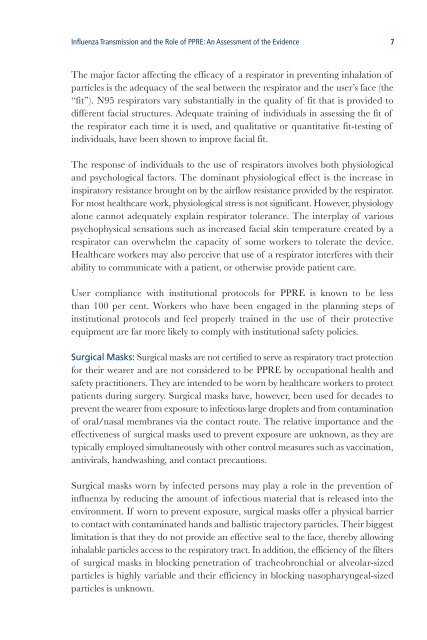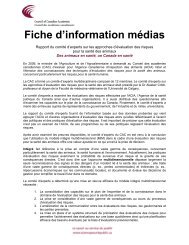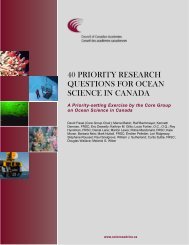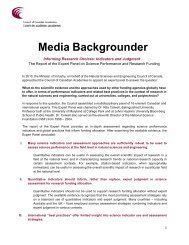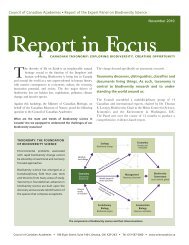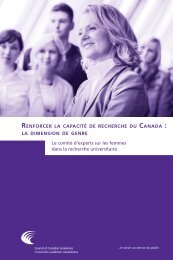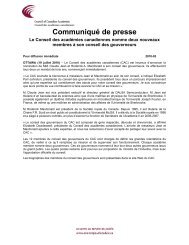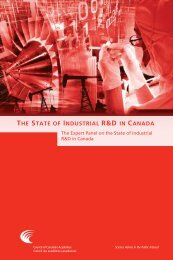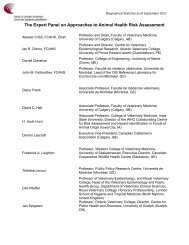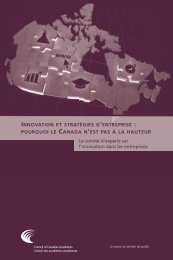an assessment of the evidence - Council of Canadian Academies
an assessment of the evidence - Council of Canadian Academies
an assessment of the evidence - Council of Canadian Academies
- No tags were found...
You also want an ePaper? Increase the reach of your titles
YUMPU automatically turns print PDFs into web optimized ePapers that Google loves.
Influenza Tr<strong>an</strong>smission <strong>an</strong>d <strong>the</strong> Role <strong>of</strong> PPRE: An Assessment <strong>of</strong> <strong>the</strong> Evidence 7The major factor affecting <strong>the</strong> efficacy <strong>of</strong> a respirator in preventing inhalation <strong>of</strong>particles is <strong>the</strong> adequacy <strong>of</strong> <strong>the</strong> seal between <strong>the</strong> respirator <strong>an</strong>d <strong>the</strong> user’s face (<strong>the</strong>“fit”). N95 respirators vary subst<strong>an</strong>tially in <strong>the</strong> quality <strong>of</strong> fit that is provided todifferent facial structures. Adequate training <strong>of</strong> individuals in assessing <strong>the</strong> fit <strong>of</strong><strong>the</strong> respirator each time it is used, <strong>an</strong>d qualitative or qu<strong>an</strong>titative fit-testing <strong>of</strong>individuals, have been shown to improve facial fit.The response <strong>of</strong> individuals to <strong>the</strong> use <strong>of</strong> respirators involves both physiological<strong>an</strong>d psychological factors. The domin<strong>an</strong>t physiological effect is <strong>the</strong> increase ininspiratory resist<strong>an</strong>ce brought on by <strong>the</strong> airflow resist<strong>an</strong>ce provided by <strong>the</strong> respirator.For most healthcare work, physiological stress is not signific<strong>an</strong>t. However, physiologyalone c<strong>an</strong>not adequately explain respirator toler<strong>an</strong>ce. The interplay <strong>of</strong> variouspsychophysical sensations such as increased facial skin temperature created by arespirator c<strong>an</strong> overwhelm <strong>the</strong> capacity <strong>of</strong> some workers to tolerate <strong>the</strong> device.Healthcare workers may also perceive that use <strong>of</strong> a respirator interferes with <strong>the</strong>irability to communicate with a patient, or o<strong>the</strong>rwise provide patient care.User compli<strong>an</strong>ce with institutional protocols for PPRE is known to be lessth<strong>an</strong> 100 per cent. Workers who have been engaged in <strong>the</strong> pl<strong>an</strong>ning steps <strong>of</strong>institutional protocols <strong>an</strong>d feel properly trained in <strong>the</strong> use <strong>of</strong> <strong>the</strong>ir protectiveequipment are far more likely to comply with institutional safety policies.Surgical Masks: Surgical masks are not certified to serve as respiratory tract protectionfor <strong>the</strong>ir wearer <strong>an</strong>d are not considered to be PPRE by occupational health <strong>an</strong>dsafety practitioners. They are intended to be worn by healthcare workers to protectpatients during surgery. Surgical masks have, however, been used for decades toprevent <strong>the</strong> wearer from exposure to infectious large droplets <strong>an</strong>d from contamination<strong>of</strong> oral/nasal membr<strong>an</strong>es via <strong>the</strong> contact route. The relative import<strong>an</strong>ce <strong>an</strong>d <strong>the</strong>effectiveness <strong>of</strong> surgical masks used to prevent exposure are unknown, as <strong>the</strong>y aretypically employed simult<strong>an</strong>eously with o<strong>the</strong>r control measures such as vaccination,<strong>an</strong>tivirals, h<strong>an</strong>dwashing, <strong>an</strong>d contact precautions.Surgical masks worn by infected persons may play a role in <strong>the</strong> prevention <strong>of</strong>influenza by reducing <strong>the</strong> amount <strong>of</strong> infectious material that is released into <strong>the</strong>environment. If worn to prevent exposure, surgical masks <strong>of</strong>fer a physical barrierto contact with contaminated h<strong>an</strong>ds <strong>an</strong>d ballistic trajectory particles. Their biggestlimitation is that <strong>the</strong>y do not provide <strong>an</strong> effective seal to <strong>the</strong> face, <strong>the</strong>reby allowinginhalable particles access to <strong>the</strong> respiratory tract. In addition, <strong>the</strong> efficiency <strong>of</strong> <strong>the</strong> filters<strong>of</strong> surgical masks in blocking penetration <strong>of</strong> tracheobronchial or alveolar-sizedparticles is highly variable <strong>an</strong>d <strong>the</strong>ir efficiency in blocking nasopharyngeal-sizedparticles is unknown.


